This post may contain affiliate links.
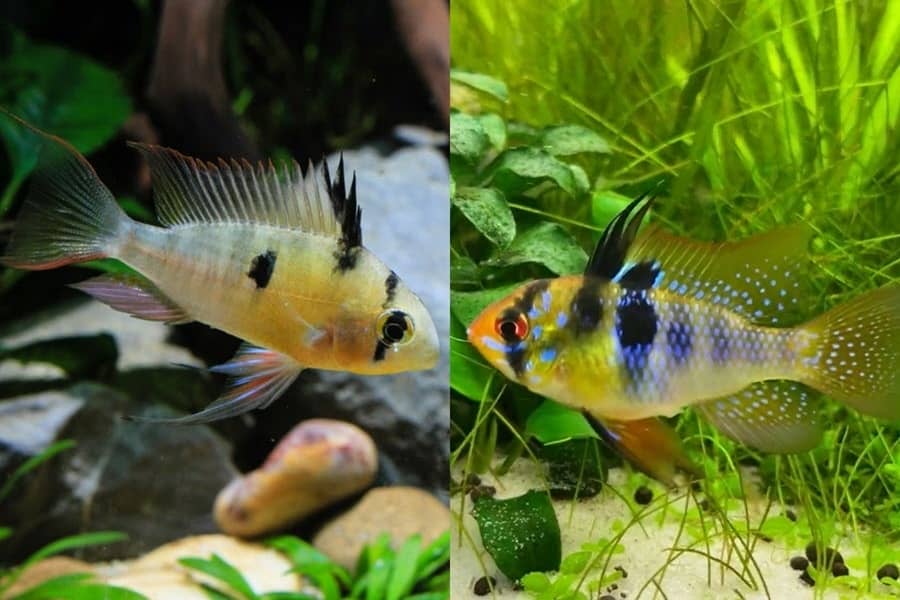
There are many similarities between the Bolivian ram and the German blue ram. They are both members of the same family, and they are both considered to be peaceful fish. But what are the main differences between these two breeds?
The main differences are that Bolivian rams are low-maintenance, they can stand the cold water better, are bigger than the German ones, and are easier to breed and find. German blue rams, on the other hand, are smaller, more colorful, and more difficult to breed.
There is a lot to know about these two kinds of fish. Both share many similarities and have differences, which we will explore in the article. We will discuss the pros and cons of each fish and suggest which type better suits your lifestyle.
What Is the Bolivian Ram?
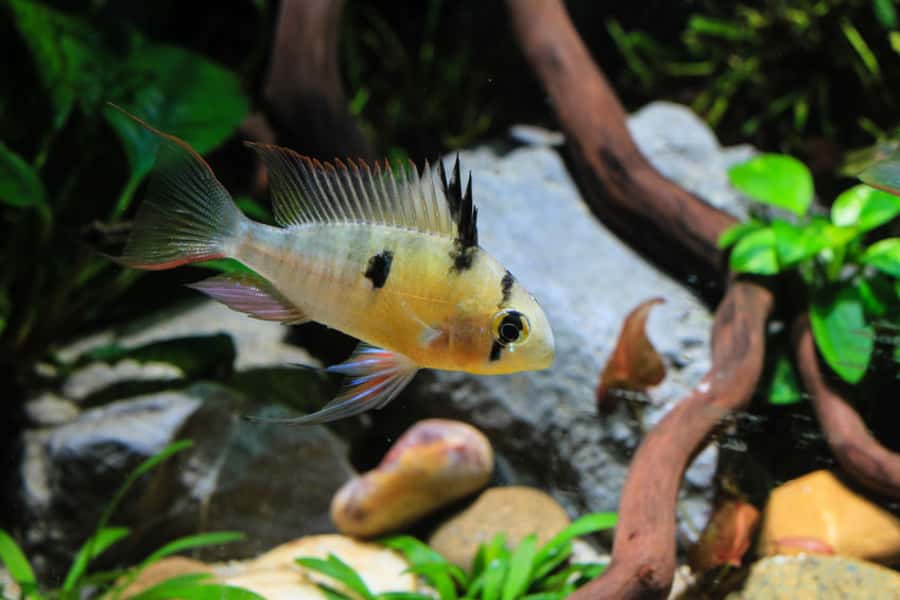
The Bolivian Ram is a type of fish that is endemic to the Amazonian river in Brazil and Bolivia. They are also known as Bolivian butterflies, Bolivian ram cichlid, and ruby clown cichlid. They are part of the Cichlidae family. They are omnivorous, which means that they feed on small organisms and plant material.
Bolivian rams have a reputation as a perfect aquarium fish. Many fish enthusiasts agree that they are great for beginner breeders. This is because they tend to be peaceful creatures, which is a contrast with the other members of their family.
The Bolivian ram is also tolerant of cold temperatures and can handle a wide range of water conditions. However, replicating their natural environment is recommended as they prefer acidic waters with tempered weather conditions.
Female and male Bolivian rams have different sizes and colors. The female tends to be smaller and has a different belly color.
How to Take Care of Bolivian Rams?
Bolivian rams are hardy fish. Therefore, they will be happy and healthy as long as their water changes every week. Keep an eye on the oxygen levels as it is the only aspect they are not resistant to.
Bolivian rams are susceptible to parasites. One of the most common ones in these cichlids is the white spot disease. This is also known as Ich. If you notice white spots in their body that were previously not there, then try raising that temperature to 86°F (30℃). Wait to see if it goes away.
If the parasite remains, you will need to use copper, a great option when dealing with parasites in tanks. Just be careful because using copper could damage the plants in your tank.
Bolivian rams need a place to hide. Therefore, you should choose a good plant ecosystem for them. We recommend you java fern, amazon sword, anubias nana, or wisteria. Add a couple of rocks, and you will have a happy Bolivian ram.
Best Tank Mates for Your Bolivian Ram
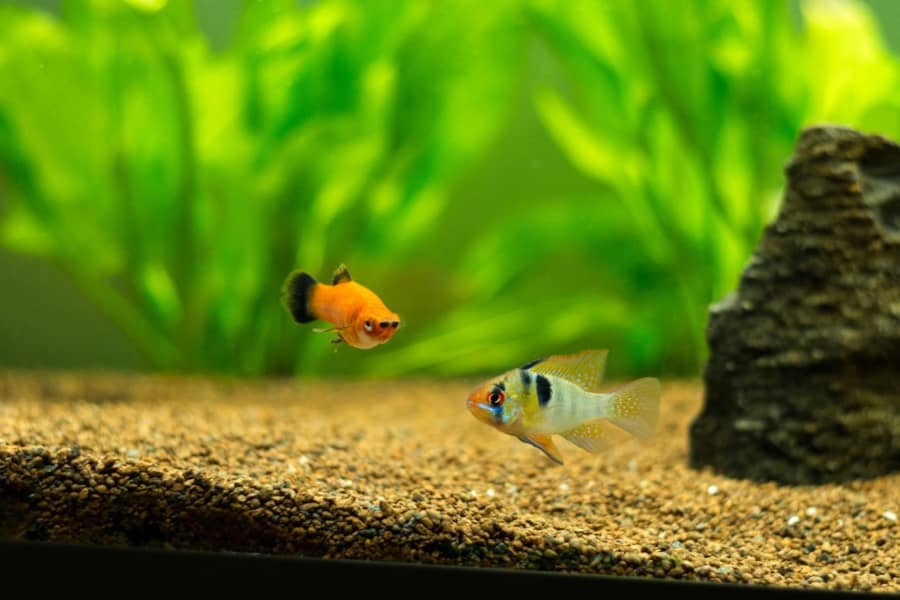
Bolivian rams are peaceful and shy. With this in mind, avoid any aggressive fish in their community. They will get along well with other dwarf cichlids and other peaceful fishes.
We recommend the following as mates for your Bolivian Ram:
- Silver dollars
- Rummy nose
- Dwarf gouramis
- Emperor tetras
- Guppies
- Platies
- Odessa barbs
- Tiger barbs
Avoid placing smaller fishes or plants as they might confuse them with food.
Overall, Bolivian rams are shy and won’t interact much with other fishes. Therefore, it is okay if you get a tank only for them.
What Tank Set-Up Do Bolivian Rams Need?
Bolivian rams are hardy fish, so you won’t need to keep them in a specific setup. But if you can replicate their natural environment, they will appreciate it.
They are native to the coldest parts of the Amazonian rivers in Bolivia and Brazil. However, they can tolerate temperatures up to 87°F (30.6℃).
They can stand pH levels between 6 and 7.5. Therefore, you should adjust it depending on which other fishes you will have in the tanks.
These fish require places to hide and breed, so add rocks in the bottom and plants. If you have the fish in an exposed aquarium, they will feel intimidated by the other fish. Give them enough space, and they will live healthy for at least four years.
What Is the German Blue Ram?

German blue rams are small and colorful. They are part of the Cichlidae family and are considered to be peaceful fish. German blue rams tend to be yellow, blue, and white. Many consider them captivating fishes for aquariums thanks to their bright colors and fascinating shapes.
Surprisingly, the German blue ram does not come from Germany. They come from South America. This fish is native to the Amazonian rivers of Colombia and Venezuela.
The name German comes from a color variation of the fish. Originally, German blue rams had different shades of blue. German breeders decided on the current shade of blue and bred their rams to continue that color line.
They are a kind of fish that prefers a more acidic environment like the ones found in South American rivers. Unlike the Bolivian rams, German blue rams need a warmer water temperature.
The German blue ram is an omnivore, which means that they eat plant material and small organisms. You will need to provide them with a balanced diet that uses plant and meat-based products.
The female and male German blue rams are different. The male will be ½ an inch to an inch (1.3 to 2.5cm) longer than the female, and the females present a pinkish tone in their bellies.
German blue rams need a specific set of water conditions, as well as a proper diet. This means that they are difficult fishes to breed.
If you want to know more about this ram, you can check out this video:
How to Take Care of the German Blue Ram?
German blue rams require a lot of care. They are sensitive to water changes, so be careful when placing them in new aquariums.
They need frequent water changes. At least once a week, you should change 20% of the water in the tanks. You will need to change even more if you have a heavily stocked water tank. If you neglect this, the health of your German blue rams could suffer.
When changing the water, you must treat and temper the new water before adding it. German blue rams are susceptible to fish tuberculosis, which is a disease that can also affect humans. The common symptoms you will see are the following:
- Your fish will get thinner.
- They might present ulcers around the head and body.
- Their eyes will get droopy.
If you notice these symptoms, be careful, and do not interact with the water without protection. The fish can pass on the disease to you. Remove the water carefully and change the entire environment to get rid of it.
Best Tank Mates for Your German Blue Ram
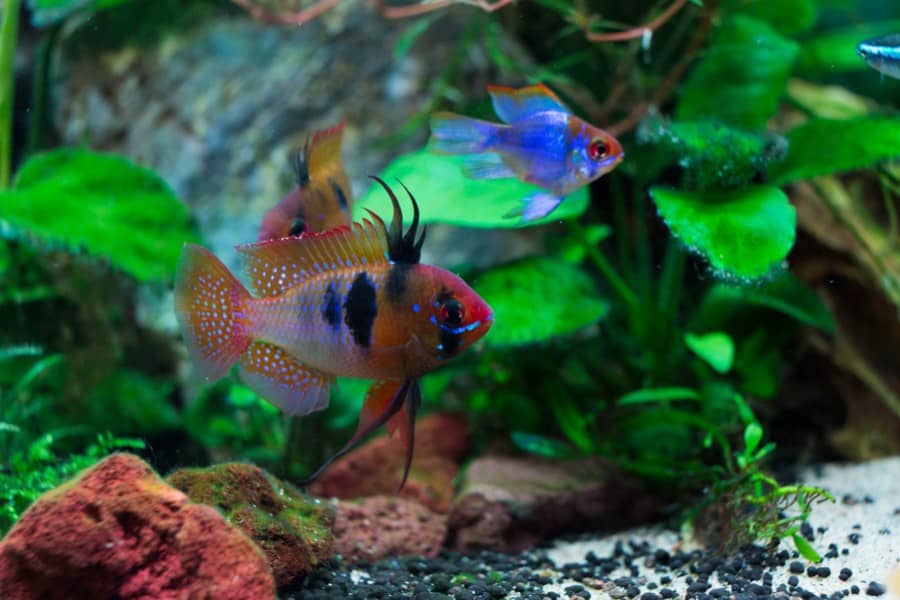
This is a peaceful fish that requires a peaceful community. They will have a hard time in an aggressive aquarium. They will get along with other Dwarf Cichlids and peaceful non-Cichlids.
With this in mind, we recommend the following fishes as your German blue ram companions:
- Corydoras
- Rummynose Tetras
- Silver Dollars
- Dwarf Gouramis
- Discus
- Plecostomus Catfish
Cardinal and Neon Tetras - Clown Loaches
We do not recommend adding smaller fishes or plants as they might look like food.
Overall, German blue rams are good with gentle communities or living alone. Do not mix males in the same tank. They might fight for territory until one of them dies.
What Tank Set-Up Do German Blue Rams Need?
German blue rams are a delicate type of Cichlid, and they won’t endure a different environment than their natural one.
Keep the water with a soft current, always keeping an eye on the oxygen and nitrate levels.
Change the water every week, and make sure the new water is tempered and treated. The best temperature for them is around 80°F (26.7℃).
German blue rams need a water hardness of around 6 to 14 dGH. This means keeping in balance the calcium and magnesium levels in the tank.
German blue rams also need a lot of rocks and plants to hide. However, make sure to keep free space for them to swim around.
Similarities Between the Bolivian Ram and the German Blue Ram
Bolivian Rams and German Blue Rams Are From the Same Family
Bolivian rams and German blue rams belong to the Cichlids family. They are both considered dwarf Cichlids and share many similarities in behavior and personality.
They are the only two Cichlids to be considered peaceful fishes. Other members of the family tend to be aggressive towards other fishes.
They Are Both Good Options for Aquariums
The German blue ram is a perfect choice for your aquarium because of its colorful looks and playful nature. They are eye-catching, and if properly cared for, they will grow into a big community.
The Bolivian Ram is very resistant and peaceful. These are two attributes that a fish needs to survive in a community tank. They will get along with most fishes, and the males won’t fight to the death for territory like other Cichlids.
They Have a Similar Availability and Price
Both the German blue ram and the Bolivian ram are widely available. They are the two most common Cichlids in aquariums, so you won’t have a hard time finding a trusted place to get one.
Their price is usually similar, although a properly bred Bolivian ram will cost a bit more as there is more demand for them.
You will be able to get a good Bolivian ram specimen for 10USD. However, you can find the German blue ram for around 8USD.
Main Differences Between Bolivian Rams and German Blue Rams
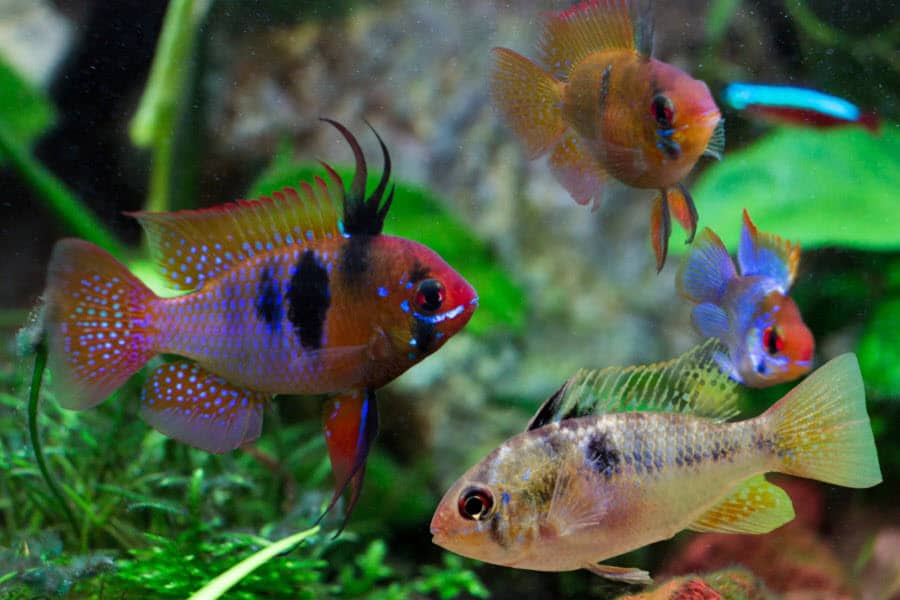
Size and Appearance
They are both colorful fish, but there are many differences in appearance between the Bolivian ram and the German blue ram.
The German blue ram is smaller. It can grow to a maximum of 2 inches (5.1cm). The Bolivian Ram can grow up to 3.5 inches (8.9cm).
The Bolivian ram has a colorful look, but its colors are less bright than the German blue ram. The latter is also known as the rainbow ram.
Typical Behavior
Although they are both peaceful creatures, the Bolivian rams are shy fish. This means that given the necessary space and hiding places, they will spend most of the time in the lower and middle parts of the tank.
On the other hand, the German blue rams are more daring and will spend time swimming around every inch of the tank. They are also very playful and will dance during mating seasons to attract females.
The Bolivian ram’s swimming pattern is unique, while that of the German blue Ram is not. The Bolivian Ram will give a few strokes and then stop all of a sudden and will repeat it over and over again.
Bolivian rams are also generally more intelligent than the German blue rams. This can be noticed thanks to their interaction with objects and movements outside the tanks. They are also known to follow fingers, which is something only intelligent fishes can do.
Another difference in their behavior is their eating habits. Bolivian rams will eat almost anything they can put in their mouths. However, German blue rams are picky eaters and won’t go for common foods.
Water Temperature and Ph Needs
One of the key differences between the Bolivian ram and the German blue ram is their ability to adapt to different environments.
The German blue ram requires a warm temperature of around 78° to 85° F (25.6 to 29.4℃) to survive. They also need a slow current and subdued light, as well as a Ph of around 6 to 7.5. This is the reason why German blue rams have a reputation as a delicate type of fish.
The Bolivian ram is a hardy fish, meaning that it can adapt to different water environments. It does not need a specific water temperature, and it can thrive in low or high pH levels. However, we recommend emulating their natural environment to keep them healthy for a longer time.
Another interesting distinction is the amount of space needed for each ram. You will need 30 gallons (113L) per specimen for the Bolivian ram, while the German blue ram only needs 10 gallons (38L) per specimen.
Which One Should You Choose?
It all comes down to what you are planning to do with your fish. If you want the most eye-catching fish for your aquarium, then the German blue ram is the one for you. However, if you want to start breeding and do not have much experience with fish, then the Bolivian Ram is the go-to.
If you want to know which one to choose, ask yourself the following questions:
- Do I want them for breeding? If you do, and you have experience breeding other species, you can choose the one you like the most. But if you are going to start breeding for the first time, we recommend going for the Bolivian Ram because it is easier to breed than the German blue Ram.
- How big is the tank or aquarium I will be using? If you are planning less than 30 gallons (113L) per Ram, then we suggest you choose a German blue ram. They do not need much space and will not require more than 10 gallons (38L) per specimen.
- Will I have enough time to make sure the rams are healthy and happy? Maintenance is important for every fish, but some fishes need it more than others. If you do not have much time to spend on your tank, we recommend choosing the Bolivian Ram. They need a lot less time and will mostly require a change of water every two days.
- Do I want a playful and colorful fish or one that can interact with me? If you want playful and colorful, then the German blue Ram is the best option. They will dance, they will play, and they will be a good spectacle for your aquarium. However, they are not the smartest. Therefore, if you want a fish that will recognize you and interact with you, then the Bolivian Ram could be your best choice.
Think about your goals with each specimen and then choose based on what you want and need from a ram. Don’t be afraid of placing these two rams in the same tank.
Conclusion
There are a lot of differences and similarities between Bolivian and German rams.
Bolivian rams are the easiest to breed. They are bigger and less high-maintenance than their German counterparts. It is a great option if you are starting as a breeder, and it will be an excellent addition to any aquarium.
On the other hand, the German Blue Ram is smaller, requires more caring, and does not get along with smaller fishes.
Keep in mind that while they have many differences, they are both great options for breeding or aquariums. So choose one or both; the choice is yours.
Read Also:
